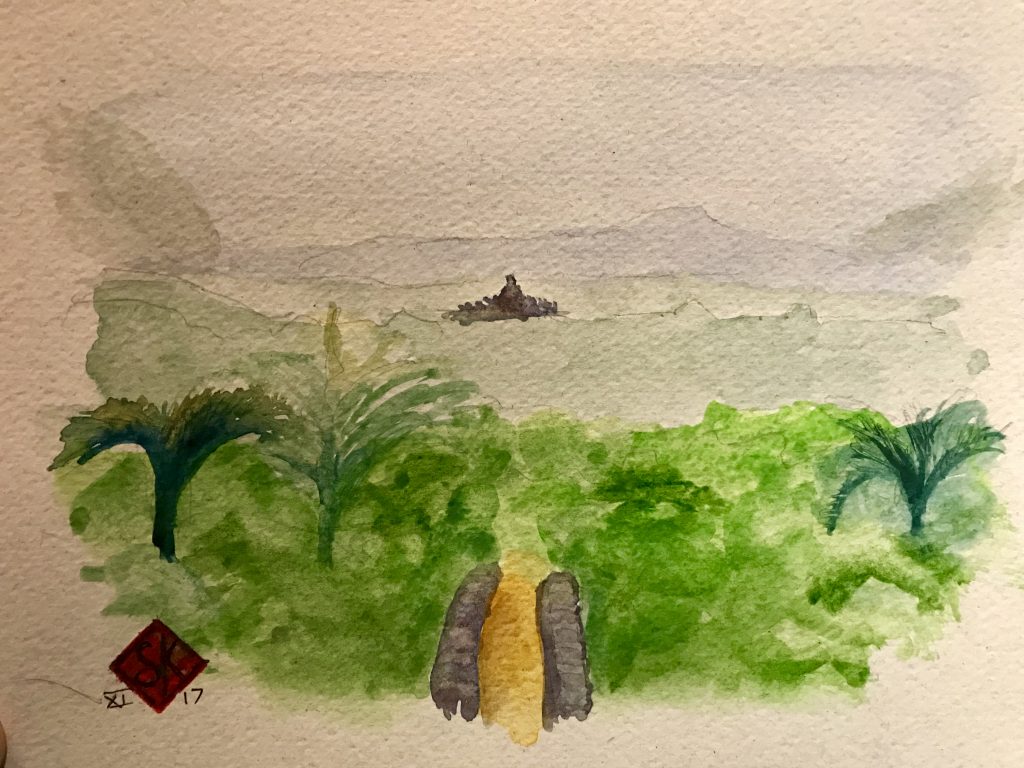The Rain Lets Up
After yesterday’s torrential, unremiting rains, it was nice to wake up to a clearing sky. What a difference! There are two huge mountains in the view from our villa, and they were totally obscured by the rain and fog. I didn’t even see them until this morning! Also great because today is our last day here, and we have three “Culture Trails” items to take advantage of.
But let’s catch up on a few things first: The rain has made all the walkways at the resort slippery. Most are paved with polished concrete, or that white stone that the buildings are clad with. And Mary slipped and took a fall, and hurt her knee. As I’m writing this, in the evening, her knee has improved considerably, but it really hurt, and she could hardly walk in the morning. Luckily the resort had a cane to lend her, which helped a great deal.
The other thing, a piece of advice I forgot to mention earlier: If you ever have the opportunity to attend the Ramayana performance in Yogyakarta, eat dinner first. They offer a buffet dinner at the theater, but my recommendation is to avoid it.
Borobudur
Part of the package at the Amanjiwo resort is three “cultural trails” I mentioned earlier — activities or outings. We opted to visit the local market, to see some of the local ruins, and to have a typical Javanese dinner.
The first stop was a famous Buddhist temple, Borobudur, which we can actually see from the resort. Here’s how it looked from the resort, from a few miles off, before the rain let up:

Another thing the resort does is provide each room with a little set of watercolors, a brush, and some paper. You’re expected to do a small painting, then submit it into a kind of register in their library. That’s where this little view of the temple will go.
The temple itself is magnificent, every bit as impressive as much of what we saw in Angkor. It’s huge, with about 200 steps leading up nine levels. Mary was proud that she beat me to the top, even with a bum knee.
Borobudur was derelect for a long period. Buddhists had moved away from this location, so for centuries it was ignored and was falling to ruin. Even though only a very tiny minority of Indonesians are actually Buddhists, the government has taken on extensive conservation efforts and is promoting the temple as being historically important. We met a number of Javanese school groups who were studying the site.
Thereby hangs another tale. Many of these kids — and adults! — were from distant parts of Java, and had never met “outsiders” as our guide described us. They had smart phones and selfie sticks, though, and Mary and I (and a couple of other Westerners that were there today) were a cause celebre. Everybody wanted a photo with us!
The other two sites we visited were tiny by comparison, though one is in fact a functioning Buddhist temple, with an adjacent monastery (total, 5 monks!)
The Market
We also visited the local food market. This was pretty dismal by comparison to the ones we saw even in the poorest countries we visited last year. It is located in what our guide describes as not a poor town, but the building, if you could call it that, is a rambling collection of shacks strung together, roofed by a patchwork of old tin, hunks of plastic, and whatnot. The fare being sold was local produce: fruit, vegetables, some lightly processed foodstuffs like bean curd (something we don’t see at home), tofu, fried stuff; useful handicrafts; and common, useful items, like clothing, utensils, some packaged food. Some people were selling freshly slaughtered and cleaned chickens and some small, I guess locally farmed, fish. The conditions were not at all sanitary.
The Javanese Meal
For the third of the “Trails” Mary and I were treated to a traditional Javanese dinner. It was very special: When we got to the table, it was decked out with candles surrounded by arrangements of rose petals and jasmine flowers, in honor of an anniversary of sorts. The meal itself started with soup, Sroto Sokaraja, a highly spiced chicken soup. The main course followed, a taster of six Javanese classics: Gado Gado, a vegetable melange; Ikan Sambal Matah, grilled fish with typical Javanese spices; Redang, a beef stew; Lodeh, vegetables simmered in coconut milk; Bebek Lambak Ija, crisp-roasted duck; Lumpia Semarang, a deep-fried spring roll. Desert was a plate of fruit, with a Nanas Molen, fried pineapple chunk wrapped in pastry — and a beautiful little chocolate opera cake to celebrate the occasion.
Meanwhile, we are monitoring events in Bali. Apparently the airport opened again this afternoon, even though we saw pictures on the news of more eruptions, and lava flowing down the sides of Mount Agung.
